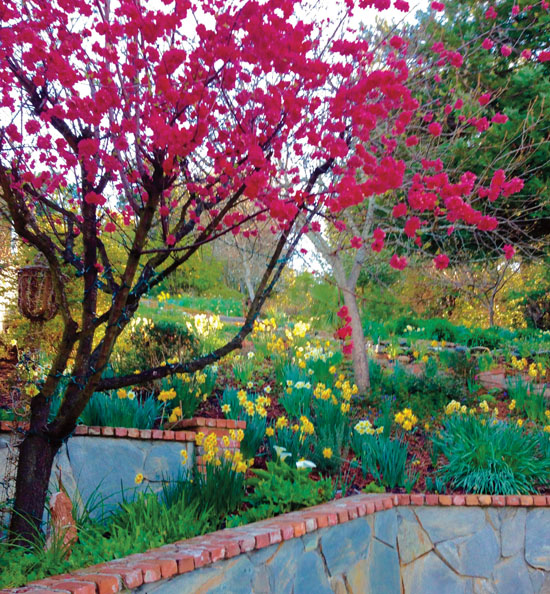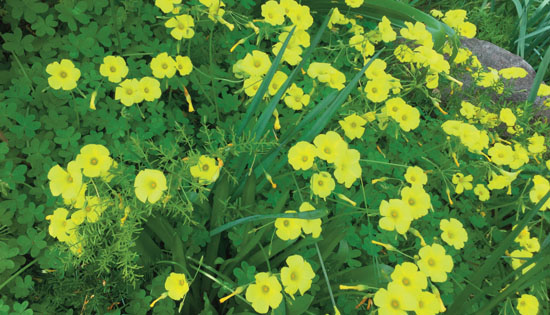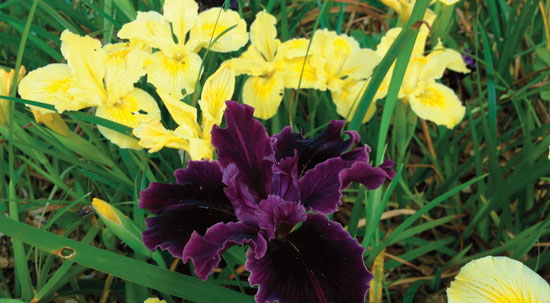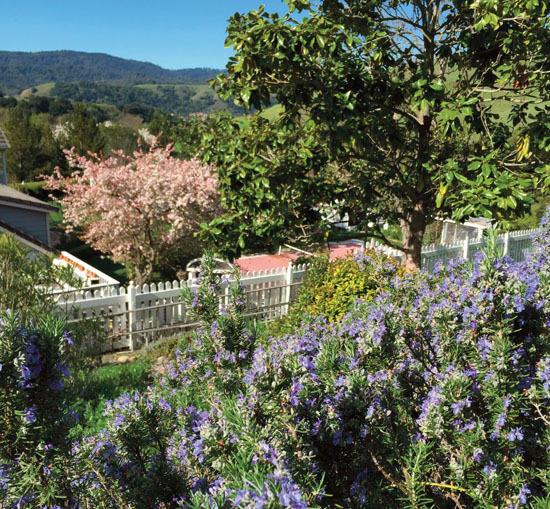 | | | Hillside of daffodils with peach tree in bloom. Photos Cynthia Brian | | | | | | After visiting the Yucatan Peninsula for a week at the end of February where I snorkeled and swam in underground cenotes (rivers) as well as the aqua waters of the Caribbean, I returned to a garden exploding in blooms. Bearded iris, tulips, anemones, freesia, cyclamen, calla lilies, oxalis, Chinese fringe, rosemary, ranunculus, cineraria, gladioli, periwinkle, plus hillsides of daffodils as well as fruit trees of Asian pear, peach, apricot, prune and crabapple. As the wind blew, the air rained pear blossoms. The soothing smell of springtime permeated my nostrils. How lovely to come home to beauty.
 The recent insert in our water bill made me laugh with ways to use only 35 gallons a day. Besides the fact that they failed to recognize that most households contain more than one individual, they also completely overlooked water for gardens, indoor plants and pets. Although my water conservation efforts have placed me in the top 20 percent of savers, the water company also recognized that 68 percent of my water usage is for landscaping. If only we had access to the water of those 6,000 cenotes from the Yucatan we wouldn't be worrying about irrigating our gardens.
The recent insert in our water bill made me laugh with ways to use only 35 gallons a day. Besides the fact that they failed to recognize that most households contain more than one individual, they also completely overlooked water for gardens, indoor plants and pets. Although my water conservation efforts have placed me in the top 20 percent of savers, the water company also recognized that 68 percent of my water usage is for landscaping. If only we had access to the water of those 6,000 cenotes from the Yucatan we wouldn't be worrying about irrigating our gardens.
 Many emails have arrived asking about more information on the Pearl's Premium lawn seed. Since the ground is warming, yet the heavens still shower us with rainfall, March is an opportune time to seed and reseed your lawns. Since my Nov. 4 article (www.lamorindaweekly.com/archive/issue0918/Digging-Deep-Gardening-with-Cynthia-Brian.html) about this award-winning lawn seed, I have learned about new research indicating that the roots grow to 20 inches, making the grass, once established, very drought resistant. The one drawback that I have discovered from my personal experience is that in our area, the birds do indeed like the seeds. Make sure to roll the seeds for good soil contact and water deeply. Water daily until sprouting occurs. You may have to over seed a few times to get the lush green thickness you desire.
Many emails have arrived asking about more information on the Pearl's Premium lawn seed. Since the ground is warming, yet the heavens still shower us with rainfall, March is an opportune time to seed and reseed your lawns. Since my Nov. 4 article (www.lamorindaweekly.com/archive/issue0918/Digging-Deep-Gardening-with-Cynthia-Brian.html) about this award-winning lawn seed, I have learned about new research indicating that the roots grow to 20 inches, making the grass, once established, very drought resistant. The one drawback that I have discovered from my personal experience is that in our area, the birds do indeed like the seeds. Make sure to roll the seeds for good soil contact and water deeply. Water daily until sprouting occurs. You may have to over seed a few times to get the lush green thickness you desire.
 PICK up all fallen camellias to prevent petal blight on the plant. Remember that camellia bushes grow into camellia trees so plant in an appropriate location.
PICK up all fallen camellias to prevent petal blight on the plant. Remember that camellia bushes grow into camellia trees so plant in an appropriate location.

 PLANT asparagus crowns as soon as the soil is dry enough to work.
PLANT asparagus crowns as soon as the soil is dry enough to work.

 SOW Irish potatoes, English peas, radishes, turnips, kale and carrots any time this month.
SOW Irish potatoes, English peas, radishes, turnips, kale and carrots any time this month.

 ATTRACT Monarch butterflies to your garden by planting milkweed. A caterpillar increases its body mass 2,000 times as it nibbles on milkweed.
ATTRACT Monarch butterflies to your garden by planting milkweed. A caterpillar increases its body mass 2,000 times as it nibbles on milkweed.

 ADD the perennial vegetable rhubarb to your potager along with strawberries. They'll be ready to harvest at the same time, just right for pies, jams, sauces and other treats.
ADD the perennial vegetable rhubarb to your potager along with strawberries. They'll be ready to harvest at the same time, just right for pies, jams, sauces and other treats.

 ESPALIER apples, kiwis and grapes for easier picking as well as space saving.
ESPALIER apples, kiwis and grapes for easier picking as well as space saving.

 THICKEN and reseed lawns in thin spots. Clover is an excellent option if you are seeking something other than grass.
THICKEN and reseed lawns in thin spots. Clover is an excellent option if you are seeking something other than grass.

 FERTILIZE lawns with an organic feed high in nitrogen. All plants can use a boost of nitrogen.
FERTILIZE lawns with an organic feed high in nitrogen. All plants can use a boost of nitrogen.

 TIME for a tetanus shot if you haven't had one in 10 years. Tetanus does not occur just from rusty nails. You can get it from digging in the dirt.
TIME for a tetanus shot if you haven't had one in 10 years. Tetanus does not occur just from rusty nails. You can get it from digging in the dirt.

 REPEL insects naturally with swaths of pennyroyal, nasturtium, calendula and marigold.
REPEL insects naturally with swaths of pennyroyal, nasturtium, calendula and marigold.
 NET plants, shrubs and trees that you don't want nibbled by birds, deer, rabbits and other foragers.
NET plants, shrubs and trees that you don't want nibbled by birds, deer, rabbits and other foragers.

 DIVIDE agapanthus, daylilies and iris while they are still semi-dormant.
DIVIDE agapanthus, daylilies and iris while they are still semi-dormant.

 COMPOST all organic matter to add to your garden. This includes newspaper, shredded cardboard, food scraps (except meat), eggshells, tea leaves and coffee grinds.
COMPOST all organic matter to add to your garden. This includes newspaper, shredded cardboard, food scraps (except meat), eggshells, tea leaves and coffee grinds.

 BUILD hugels now while the soil is still easy to dig to help with moisture retention for the summer months.
BUILD hugels now while the soil is still easy to dig to help with moisture retention for the summer months.

 PLAN your vegetable garden. Check the soil, turn over the cover crops, determine the sunlight conditions, choose your seeds, and write a list of plants you wish to purchase to keep you eating fresh all season.
PLAN your vegetable garden. Check the soil, turn over the cover crops, determine the sunlight conditions, choose your seeds, and write a list of plants you wish to purchase to keep you eating fresh all season.

 PLANT culinary herbs including cilantro, chives, dill, mint, parsley, rosemary and thyme to spice up your meals all season.
PLANT culinary herbs including cilantro, chives, dill, mint, parsley, rosemary and thyme to spice up your meals all season.

 PREPARE for Easter celebrations with arrangements of tulips, hyacinths, lilies and colorful annuals.
PREPARE for Easter celebrations with arrangements of tulips, hyacinths, lilies and colorful annuals.

 START seeds of eggplants, tomatoes and peppers indoors to get a head start on your summer barbecues.
START seeds of eggplants, tomatoes and peppers indoors to get a head start on your summer barbecues.

 WEED! After all the rainfall, weeds are proliferating. Start pulling them up or turning them under before seedpods set.
WEED! After all the rainfall, weeds are proliferating. Start pulling them up or turning them under before seedpods set.

 EXHALE! Winter is almost over and the sunny, warm, longer days of March are here. Getting ready to balance eggs on end on the vernal equinox ... or at least crack a couple of fresh ones for breakfast.
EXHALE! Winter is almost over and the sunny, warm, longer days of March are here. Getting ready to balance eggs on end on the vernal equinox ... or at least crack a couple of fresh ones for breakfast.

 Allow your surroundings to sink deeply into your soul. You have the power to bring beauty to your everyday environment.
Allow your surroundings to sink deeply into your soul. You have the power to bring beauty to your everyday environment.

 Happy Gardening! Happy Growing! Happy Spring! (almost)
Happy Gardening! Happy Growing! Happy Spring! (almost)

|




